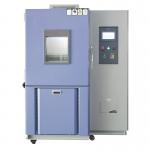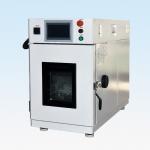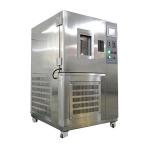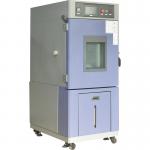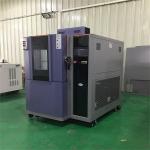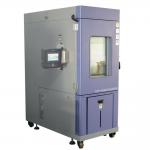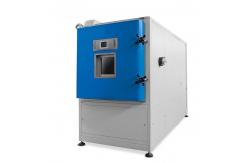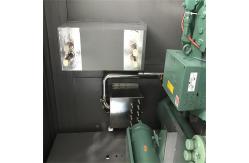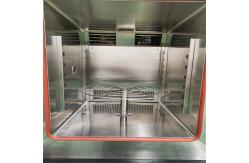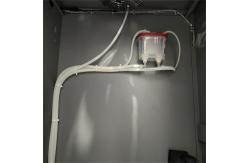In the modern manufacturing landscape, ensuring the long-term
durability and reliability of products is of utmost significance.
The customized Ozone Aging Test Chamber emerges as a crucial tool
for a wide range of industries, enabling them to evaluate the
resistance of materials and products to the deleterious effects of
ozone exposure. This specialized test chamber is designed to replicate and control
ozone-rich environments. It serves industries such as automotive,
rubber and plastics, textiles, and electronics. The primary
objective is to subject samples to a specific concentration of
ozone and monitor the resulting degradation over time. By doing so,
manufacturers can assess the ozone resistance of materials,
optimize product formulations, and ensure compliance with industry
standards and regulations. - Robust and Sealed Chamber Construction
- The ozone aging test chamber is constructed with a heavy-duty
stainless steel frame and walls. The stainless steel material is
chosen for its excellent resistance to corrosion, which is
essential as ozone can be highly reactive. The chamber is carefully
sealed to prevent any leakage of ozone, ensuring a consistent and
controlled test environment. The door is equipped with a reliable
gasket and a secure locking mechanism to maintain the integrity of
the enclosure. The interior of the chamber is designed to be smooth
and easy to clean, minimizing the potential for any contaminants to
affect the test results.
- Precision Ozone Generation and Concentration Control System
- The chamber features an advanced ozone generation system. It can
produce ozone with a high degree of accuracy and stability. The
concentration of ozone can be precisely controlled within a wide
range, typically from 10 parts per million (ppm) to 1000 ppm. The
system utilizes state-of-the-art ozone generators and sensors. The
sensors continuously monitor the ozone concentration inside the
chamber and provide real-time feedback to the control unit. The
control unit then adjusts the ozone generation rate to maintain the
desired concentration level. This level of precision allows for
highly accurate and repeatable tests.
- Accurate Temperature and Humidity Control
- In addition to ozone concentration, the chamber also offers precise
temperature and humidity control. The temperature can be maintained
within a range of -20°C to +80°C, with an accuracy of ±0.5°C. The
humidity control range extends from 20% to 95% relative humidity,
with an accuracy of ±3% RH. Temperature and humidity play important
roles in the ozone aging process, as they can affect the rate of
chemical reactions. The chamber's control system ensures that these
environmental factors are kept constant and within the specified
tolerances, providing a more realistic simulation of real-world
conditions.
- Intuitive Control Panel and Data Acquisition System
- The equipment is equipped with an intuitive control panel that
allows operators to easily set and adjust the test parameters,
including ozone concentration, temperature, humidity, and test
duration. The control panel also provides real-time displays of the
current values of these parameters, as well as any alarms or
warnings. The chamber is integrated with a comprehensive data
acquisition system. It records all relevant test data, such as
ozone concentration profiles, temperature and humidity histories,
and any changes in the physical properties of the test samples. The
data can be stored in a built-in memory or exported to external
storage devices for further analysis. The system can also generate
detailed test reports in various formats, facilitating easy
documentation and sharing of results.
- Sample Fixturing and Placement Options
- The chamber is designed to accommodate a variety of sample sizes
and shapes. It can be equipped with adjustable racks, trays, and
holders to ensure proper positioning and exposure of the test
samples. The sample fixtures are made of materials that are
resistant to ozone and do not contaminate the test environment.
This flexibility allows for the testing of different products, from
small rubber components to large fabric swatches or plastic panels.
- Ozone Concentration Range and Accuracy
- As mentioned, the ozone concentration can be adjusted from 10 ppm
to 1000 ppm, with an accuracy of ±5% of the set value. This wide
range enables the testing of materials that may be exposed to
different levels of ozone in their intended applications. For
example, automotive rubber seals may need to withstand relatively
low levels of ozone, while some industrial rubber hoses may face
higher concentrations. The accurate control of ozone concentration
ensures that the test results are reliable and comparable.
- Temperature Range and Rate of Change
- The temperature range of -20°C to +80°C allows for the simulation
of a diverse range of climatic conditions. The rate of temperature
change can be adjusted up to 5°C per minute. This rapid temperature
change capability is useful for testing the thermal stability of
materials in combination with ozone exposure. For instance, in the
automotive industry, components may experience sudden temperature
changes while being exposed to ozone in the atmosphere.
- Humidity Range and Rate of Change
- The humidity range of 20% to 95% RH, with a rate of change of up to
10% RH per minute, provides a comprehensive assessment of the
effect of moisture on ozone aging. High humidity can accelerate the
degradation of some materials, while low humidity may have a
different impact. The ability to control humidity precisely helps
in understanding the complex interactions between ozone,
temperature, and humidity.
- Testing Volume and Payload Capacity
- The chamber offers a customizable testing volume, with options
ranging from 0.5 m³ to 10 m³. The payload capacity can be adjusted
according to the size and weight of the test samples, with a
maximum capacity of up to 500 kg. This allows for the testing of a
significant number of samples or larger and heavier products. For
example, in the textile industry, large rolls of fabric can be
tested to evaluate their ozone resistance.
- Test Duration and Cycling Capability
- The chamber can conduct tests for extended periods, ranging from a
few hours to several thousand hours. It also has the ability to
perform cycling tests, where the ozone concentration, temperature,
and humidity can be varied in a programmed sequence. This cycling
capability mimics the fluctuating environmental conditions that
products may encounter in real life, providing a more accurate
assessment of their durability.
|
